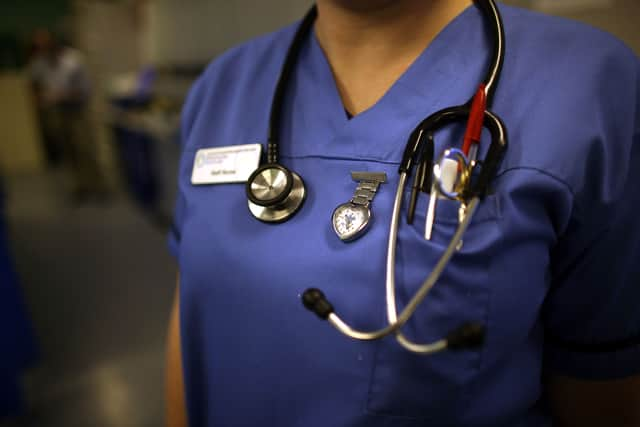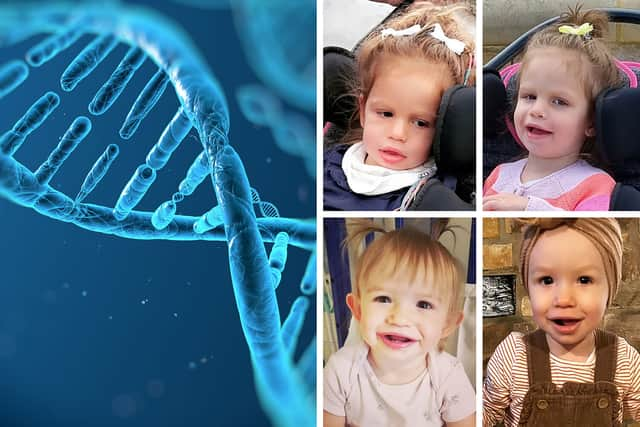What is Libmeldy? Novel genetic therapy used to treat metachromatic leukodystrophy explained
and live on Freeview channel 276
NHS doctors have used a novel genetic therapy called Libmeldy to treat a young girl with a life-threatening illness for the first time in the health service’s history.
Advertisement
Hide AdAdvertisement
Hide AdThe achievement is bittersweet. Teddi’s older sister Nala, who is three years old, also has MLD. Unfortunately, Nala’s disease had progressed too far for her to be treated with the new therapy.
“We are extremely privileged that Teddi is the first child to receive this on the NHS and grateful that she has the opportunity to lead a long and hopefully normal life,” said Ally in a statement to the NHS. “Without this treatment, we would be facing both our children being taken away.
“We can only hope that one day, a treatment becomes available for all stages of MLD, and we feel strongly that it should be added to the new-born screening test to save more families from having to go through this heartache.


What is MLD?
MLD is a rare disease that is inherited, which means the condition occurs when it is passed down from parents to their children. Specifically, MLD is a type of autosomal recessive inherited disease, which means that both parents carry it.
Advertisement
Hide AdAdvertisement
Hide AdMLD affects people due to a build-up of substances called sulphatides in the brain’s nerve cells. Normally, excessive amounts of these substances are removed from the body by an enzyme known as arylsulphatase A, but this removal process does not occur properly in people with MLD.
The resulting buildup of sulphatides means that nerve signals can be blocked from travelling around the brain, causing other parts of the body to stop functioning. As a result, young children who develop MLD tend to experience gradually worsening physical and mental symptoms over the course of a few years, though they are not painful according to the NHS’ Great Ormond Street Hospital for Children. These symptoms may include loss of sight, speech, and hearing in addition to difficulty moving, brain impairment and seizures.
MLD usually leads to death between the ages of five and eight years of age. It is estimated that MLD affects approximately one in 40,000 people in the UK.


What is Libmeldy?
Libmeldy, also called atidarsagene autotemcel, is the world’s first MLD treatment. It was developed by British pharmaceutical company Orchard Therapeutics and recommended by the UK’s National Institute for Health and Care Excellence (NICE) in February 2022.
Advertisement
Hide AdAdvertisement
Hide AdThat same month, the NHS announced it had struck a deal with Orchard to offer Libmeldy for the first time at Royal Manchester Children’s Hospital. With a reported list price of over £2.8 million, Libmeldy was the most expensive drug in the world at that time. As part of its deal with Orchard, the NHS said it managed to secure an undisclosed reduction in the price.
The treatment involves removing some stem cells from the affected patient’s bone marrow or blood. These stem cells are important because they are capable of turning into different types of blood cells.
Next, the stem cells are modified to include a copy of the gene that makes the enzyme arylsulphatase A - the same gene that is missing in people with MLD. This missing gene is introduced into the stem cells using a safe type of virus.
The modified stem cells which make up the Libmeldy medicine are then inserted back into the patient’s bloodstream where they begin producing the missing enzyme. This enzyme can then break down the sulphatide buildups, preventing MLD from occurring.
Advertisement
Hide AdAdvertisement
Hide AdBecause Libmeldy works by modifying genes, it is known as a gene therapy.


What are gene therapies?
Gene therapies are medical treatments that work by inserting genes into the body with the aim of treating a variety of diseases including genetic disorders, cancer, or long-term diseases.
Gene therapies are classed by the European Medicine Agency as a type of advanced medicine since they offer “groundbreaking new opportunities for the treatment of disease and injury.”
Aside from Libmeldy, another gene therapy used by the NHS recently is Zolgensma. It was rolled out across the health service in 2021 with the aim of treating patients with the serious genetic condition spinal muscular atrophy (SMA).
Advertisement
Hide AdAdvertisement
Hide AdNHS England’s then-chief executive Simon Stevens said at the time that the health service had “moved mountains” to make the treatment available. Similarly to Libmeldy, Zolgensma was at that time the most expensive treatment ever approved by NICE.
Comment Guidelines
National World encourages reader discussion on our stories. User feedback, insights and back-and-forth exchanges add a rich layer of context to reporting. Please review our Community Guidelines before commenting.